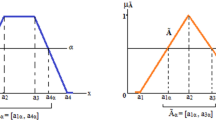Abstract
Identifying the real time of the change in a process, recognized as change point problem, simplifies the removal of change causes. In most of the change point models, the existence of different uncertainty levels is either ignored or paid a little attention to. This paper tries to address an appropriate model to estimate the multiple change points in a monotonic change process in an uncertain condition and for a known number of change points. In this regard, a novel set of membership functions and a novel objective function, based on using interval type-2 fuzzy sets, are introduced in a fuzzy-statistical clustering approach. The proposed approach, in addition to the ability of managing various amount of uncertainty, is free from the distribution of the process variables, and in the case of existence, a certain variable distribution, it is independent from it. Finally, extensive simulation studies are conducted to evaluate the performance of the proposed approach in simple step change, multiple step change, and linear trend change in the presence of isotonic change in the process mean. The results are compared with some of the powerful change point approaches.
Similar content being viewed by others
References
Ahmadzadeh F (2009) Change point detection with multivariate control charts by artificial neural network. Int J Adv Manuf Technol:1–12. doi:10.1007/s00170-009-2193-6
Aisbett J, Rickard JT, Morgenthaler D (2010) Type-2 fuzzy sets as functions on spaces. IEEE Trans Fuzzy Syst 18(4):841–844
Alaeddini A, Ghazanfari M, Amin Nayeri M (2009) A hybrid fuzzy-statistical clustering approach for estimating the time of changes in fixed and variable sampling control charts. Inf Sci 179(11):1769–1784
Amiri A, Allahyari S (2012) Change Point Estimation Methods for Control Chart Post signal Diagnostics: A Literature Review. Qual Reliab Eng Int 28(7):673–685
Bradshaw CW (1983) A fuzzy set theoretic interpretation of economic control limits. Eur J Oper Res 13(4):403–408
Castillo, O, Melin, P, (2008), Introduction to Type-2 Fuzzy Logic, in Type-2 Fuzzy Logic: Theory and Applications (book), Studies in Fuzziness and Soft Computing, Springer-Verlag, Berlin, Heidelberg.
Chang CW, Wu CR, Chen HC (2007) Using expert technology to select unstable slicing machine to control wafer slicing quality via fuzzy AHP. Expert Syst Appl 34(3):2210–2220
Fahmy HM, Elsayed EA (2006) Detection of Linear Trends in Process Mean. Int J Prod Res 44(3):487–504
Fahmy HM, Elsayed EA (2006) Drift time Detection and Adjustment Procedures for Processes Subject to Linear Trend. Int J Prod Res 44(16):3257–3278
Ghazanfari M, Alaeddini A, Niaki ST, Aryanezhad MB (2008) A clustering approach to identify the time of a step change in Shewhart control charts. Qual Reliab Eng Int 24(7):765–778
Gülbay M, Kahraman C (2007) An alternative approach to fuzzy control charts: direct fuzzy approach. Inf Sci 177(6):1463–1480
Harnish P, Nelson B, Runger G (2009) Process partitions from time-ordered clusters. J Qual Technol 41(1):3–17
Hawkins DM, Qui P, Kang CW (2003) The change-point model for statistical process control. J Qual Technol 35(4):355–366
Kazemi MS, Bazargan H, Yaghoobi MA (2014) Estimating the drift time for processes subject to linear trend disturbance using fuzzy statistical clustering. Int J Prod Res 52(11):3317–3330
Liang Q, Mendel JM (2000) Interval type-2 fuzzy logic systems: theory and design. IEEE Trans Fuzzy Syst 8(5):535–550
Melin P, Castillo O (2007) An intelligent hybrid approach for industrial quality control combining neural networks. Fuzzy Logic Fractal Theory Inf Sci 177(7):1543–1557
Mendel JM, John RI, Liu F (2006) Interval type-2 fuzzy logic systems made simple. IEEE Trans Fuzzy Syst 4(6):808–821
Mendel JM (2007) Type-2 fuzzy sets and systems: an overview. IEEE Comput Intell Mag 2(2):20–29
Montgomery DC (2005) Introduction to Statistical Quality Control, 5th edn. Wiley, New York, pp 470–472
Nishina K (1992) A Comparison of Control Charts from the Viewpoint of Change-point Estimation. Qual Reliab Eng Int 8(6):537–541
Noorossana R, Atashgar K, Saghaee A (2011) An integrated solution for monitoring process mean vector. Int J Adv Manuf Technol 56(5):755–765
Noorossana R, Heydari M (2012) Change point estimation of a normal process variance with a monotonic change. ScientiaIranica Trans E-Ind Eng 19(3):885–894
Noorossana R, Shadman A (2009) Estimating the change point of a normal process mean with a monotonic change. Qual Reliab Eng Int 25(1):79–90
Page E (1954) Continuous Inspection Schemes. Biometrika 41(1/2):100–115
Perry MB, Pignatiello JJ (2006) Estimation of the change point of a normal process mean with a linear trend disturbance. Qual Technol Quant Manag 3(3):101–115
Perry MB, Pignatiello JJ, Simpson JR (2007) Change point estimation for monotonically changing Poisson rates in SPC. Int J Prod Res 45(8):1791–1813
Perry MB, Pignatiello JJ Jr, Simpson JR (2007) Estimation of the changepoint of the process fraction nonconforming with a monotonic changedisturbance in SPC. Qual Reliab Eng Int 23(3):327–339
Samuel TR, Pignatiello JJ, Calvin JA (1998) Identifying the time of a step change with \( \overline{X} \) control charts. Qual Eng 10(3):521–527
Sedgewick R, Flajolet P (2013) An Introduction to the Analysis of Algorithms, 2nd edn. Addison-Wesley Professional, Boston
Soltys M (2012) An Introduction to the Analysis of Algorithms, 2nd edn. World Scientific Publishing Company, Singapore
Sullivan JH (2002) Detection of multiple change-points from clustering individual observations. J Qual Technol 34(4):371–383
Zadeh LA (2008) Is there a need for fuzzy logic? Inf Sci 178(13):2751–2779
Zarandi MHF, Alaeddini A (2010) A general fuzzy-statistical clustering approach for estimating the time of change in variable sampling control charts. Inf Sci 180(16):3033–3044
Zarandi MHF, Alaeddini A, Turksen IB (2008) A hybrid fuzzy adaptive sampling—run rules for Shewhart control charts. Inf Sci 178(4):1152–1170
Zarandi MHF, Alaeddini A, Turksen IB (2007) A neuro-fuzzy multi-objective design of Shewhart control charts. In: IFSA 2007 World Congress, Cancun, Mexico
Author information
Authors and Affiliations
Corresponding author
Rights and permissions
About this article
Cite this article
Zarandi, M.H.F., Najafi, S. A type-2 fuzzy-statistical clustering approach for estimating the multiple change points in a process mean with monotonic change. Int J Adv Manuf Technol 77, 1751–1765 (2015). https://doi.org/10.1007/s00170-014-6570-4
Received:
Accepted:
Published:
Issue Date:
DOI: https://doi.org/10.1007/s00170-014-6570-4




